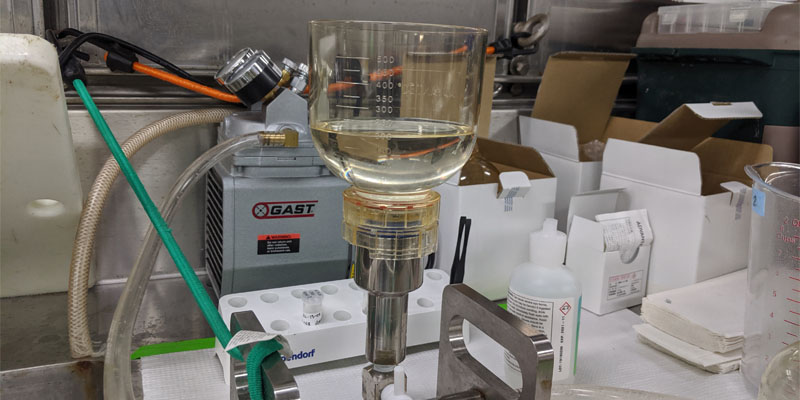Environmental DNA (eDNA)
Environmental DNA (eDNA) is the genetic material shed by organisms in the water column. By collecting samples of mucus, feces, or tissue particles, scientists can process eDNA to make new discoveries about marine life.
Environmental DNA (eDNA) is the genetic material shed by organisms into their environment. Mission personnel on the 2021 Technology Demonstration tested the use of eDNA analysis as a potential new tool that could one day be incorporated into NOAA Ocean Exploration missions to more comprehensively explore the deep sea. Video courtesy of NOAA Ocean Exploration, 2021 Technology Demonstration. Download largest version (mp4, 282 MB).
How does it work?
A scientist collects water at a location using water sampling tools such as a Niskin bottle, which can be attached to a CTD rosette or remotely operated vehicle. The samples are labeled with their latitude and longitude, depth, and filter material, as well as the salinity and temperature of where the water was collected. The eDNA is then separated from the water with a cellulose nitrate membrane filter and run through other cleaning processes. Then, each eDNA sample is either frozen or preserved in a buffer, which is an aqueous solution that both prevents degradation of the sample and makes DNA soluble (dissolvable). This allows the DNA to be stored for several years, which is important when scientists come across an unknown species and need to revisit samples.

Niskin bottles are an example of a water sampling tool that can be used for eDNA collection. Image courtesy of NOAA. Download larger version (jpg, 6.5 MB).
What happens next?
After collection, eDNA samples are sent to a lab for DNA sequencing. DNA strands have four bases – adenine, guanine, cytosine, and thymine, known by their first letter for short – and every organism has a different pattern of A, G, C, or T. Scientists barcode, or label, each base sequence in a process called metabarcoding. These samples are then compared to others in a DNA database and the organism can be identified down to its family, genus, or species.
Why is it used?
eDNA is an emerging technology that will help answer many questions about the water column and seafloor. For example, scientists may want to know what species are present in a particular location, what the biodiversity of the area is, and if any invasive or endangered species are present. eDNA can identify these organisms and characterize their role in the area’s food web and ecosystem. DNA barcoding has even been used to link larvae to their adult organisms that were previously thought to be separate species because of their appearance differences. Other organizations also use eDNA to monitor water quality and the amount of harmful bacteria in the water samples, and commercial fisheries can use it to inform their location selection and fishing practices.
eDNA also has many benefits that complement traditional sampling efforts. eDNA does not require interacting with living organisms, making it a non-invasive sampling technology. It can also offer a window into the lives of organisms that have not been captured on video footage or may ordinarily shy away from the lights of a remotely operated vehicle or other platform. eDNA can detect a wide diversity of marine life, from bacteria to vertebrates, greatly expanding the scope of an expedition.



